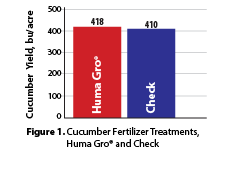By Lyndon Smith,
President and CEO
Bio Huma Netics, Inc.
 I’m excited to share that Bio Huma Netics, Inc. (BHN) has acquired an additional building in Arizona. It’s a significant milestone for us that not only testifies to the continual progress we’re making as a company but will also serve as a building block for future expansions. [Read more…]
I’m excited to share that Bio Huma Netics, Inc. (BHN) has acquired an additional building in Arizona. It’s a significant milestone for us that not only testifies to the continual progress we’re making as a company but will also serve as a building block for future expansions. [Read more…]
 In a research study, originally published in Frontiers in Plant Science, May 2021, Vol. 12:660224, the biostimulant properties of humic acids (HA) were tested on Micro Tom tomato plants under increasing nutritional stress. The results confirmed the positive role humic acids play in enhancing nutrient efficiency uptake in plants.
In a research study, originally published in Frontiers in Plant Science, May 2021, Vol. 12:660224, the biostimulant properties of humic acids (HA) were tested on Micro Tom tomato plants under increasing nutritional stress. The results confirmed the positive role humic acids play in enhancing nutrient efficiency uptake in plants.
 The 2-day in-person course will cover various key topics related to wastewater microbiology including, but not limited to, microscopy, filamentous bacteria, etc. Attendees will also get a chance to participate in various hands-on learning activities for a better understanding. To know more about the course,
The 2-day in-person course will cover various key topics related to wastewater microbiology including, but not limited to, microscopy, filamentous bacteria, etc. Attendees will also get a chance to participate in various hands-on learning activities for a better understanding. To know more about the course, 
 We are accustomed to seeing humic substances (humic and fulvic) in dry/granular form, and we tend to think of acids as liquids. So why are humic and fulvic substances called acids?All substances, solid AND liquid, have a chemical makeup. An acid is a chemical that can donate a proton (H+) to a water molecule (H2O, which would form H3O+) or to another chemical such as ammonia (NH3, which would form NH4+).
We are accustomed to seeing humic substances (humic and fulvic) in dry/granular form, and we tend to think of acids as liquids. So why are humic and fulvic substances called acids?All substances, solid AND liquid, have a chemical makeup. An acid is a chemical that can donate a proton (H+) to a water molecule (H2O, which would form H3O+) or to another chemical such as ammonia (NH3, which would form NH4+). To help increase awareness about sustainable agriculture production, Bio Huma Netics, Inc., (BHN) is sponsoring a FarmProgress course for Certified Crop Advisers (CCAs) and Pest Control Advisers (PCAs) in the United States and Canada.
To help increase awareness about sustainable agriculture production, Bio Huma Netics, Inc., (BHN) is sponsoring a FarmProgress course for Certified Crop Advisers (CCAs) and Pest Control Advisers (PCAs) in the United States and Canada.